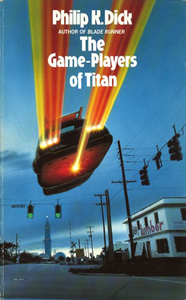The deliciously wild ideas outpace the narrative in “The Game-Players of Titan” (1963), a Philip K. Dick novel that has many loyal defenders. Although I love a lot of things about it, I have to admit that by the end I didn’t know what overarching point PKD is making nor did I grasp what happens in the final 25 percent of the novel.
Small-town Earth
The first 75 percent is a page-turning ride, though. PKD introduces a future (after a war with the vugs of Titan) where the Earth is like one big small town because the population is so low and because cars (called auto-autos) can quickly fly from one location to another.
Because of automated production and maintenance, everyone lives a life of leisure, and they get their fix of economic, property and romantic pursuits via a game called Bluff, which is like Monopoly mixed with bridge mixed with poker.

“The Game-Players of Titan” (1963)
Author: Philip K. Dick
Genre: Science fiction
Setting: Bay Area, 22nd century
This 22nd century world is a sunnier version of the one from “The Days of Perky Pat.” People are not unhealthily obsessed with Bluff; the nightly games are somewhere between a job and a party. The idea of losing a city is stressful, but the games also allow for spending time with friends and drinking.
PKD doesn’t explain Bluff’s details very well, but just when I feared the book would be all about the game, it suddenly shifts to a juicy murder mystery. Main character Pete Garden, who is perpetually depressed even before losing Berkeley and his wife Freya in the game, has day-long amnesia and his rival, Jerome “Lucky” Luckman, turns up dead.
Psis, vugs and politics
Later shifts in focus come too fast and furious to grasp, including the increased importance of Mary Anne McClain, who has a murderous psi talent, and the vugs, who are amid a political debate on Titan about whether they should cancel the truce and fully take over Earth.
The vugs – a.k.a. the titular Game-Players of Titan – have the ability to effortlessly teleport themselves and humans from Earth to Titan. And as we later learn in too-understated fashion, they can also shapeshift into specific humans.
Around this same time, PKD was penning the short story “Retreat Syndrome,” wherein a man has amnesia about a murder he supposedly committed and he is instantly teleported against his will between Earth and Ganymede.
In both that story and this novel, the crazy concept outpaces the narrative sense. In “Game-Players,” the murder of Luckman happens off-page, it’s never revisited in flashbacks and the solution ends up being less important when more bodies start piling up.
Evocative details
But it’s in the details that this novel shines. The police detectives are mind-readers, so they know right away that Pete has memory loss for the period when the murder took place. Knowledge obtained via mind-reading is not admissible in court (amazingly, the Bill of Rights still somewhat applies in this future), but detectives use it as a starting point: If they know who the killer is, it’s easier for them to obtain admissible evidence.

The passage where the detectives theorize about why and how Pete and five other members of the game-playing group may have gotten their memories erased makes for some fun deductive reasoning, like a science fiction Poirot mystery.
Going even further into the details, the anthropomorphic appliances and objects are a humorous blast. Toasters, medicine cabinets and elevators talk and have personalities. For example, an elevator feels bad when it’s told it did the wrong thing by not calling the police when a corpse was left on it.
The funniest example is the car belonging to Joe Schilling (a name recycled from “Mary and the Giant”), a friend of Pete’s. Because of faulty wiring, the car – named Max – is obstinate, responding to orders to drive somewhere with “Up yours” and other insults.
PKD is clearly having fun with this idea, but in terms of character development and humor, I think it might’ve worked better if Max belonged to Pete. There’s something particularly funny and memorable about one sad-sack protagonist as opposed to spreading the misery between Pete and Joe, as the author does in this book.
Hit-and-miss predictions
However, the concept of automatic automobiles is a rare example of PKD being on-point with a prediction of future technology. In our modern world, cars can do more and more things on their own with each new model. And if they start to develop personalities, we’ll no doubt be giving them names. (My auto-auto will be called Otto, because I can’t resist.)
On the other hand, Pete desperately needs to get in contact with his friend Joe or his wife Carol after he discovers his blackout period, and he can’t. PKD extrapolated his future tech from current tech (adding flying ability and more automation to cars) but was not good at predicting sea changes.
In his day, phone communication was tied to a location, not a person, and he did not imagine a future where that was different. PKD’s failure to predict cellphones is evident in all his stories, but it’s glaring here considering Pete’s need for their existence.
Too much of “Game-Players” is underdeveloped and confusing. Even some characters’ identities (human or vug?) are unclear by the end. An auto-auto can identify the owner’s species, but then again, auto-autos can be reprogrammed by the owner, so that’s no help.
In brain-teaser novels, authors always walk a fine line, and this one is slightly on the wrong side of that line for me to label it as an elite PKD novel. However, “Game-Players” also includes an amnesia-based murder-mystery and talking tea kettles, so I do feel affection for it.

